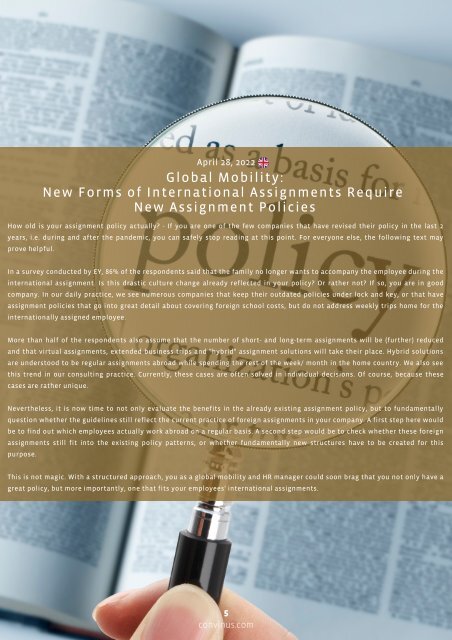CONVINUS Global Mobility Alert Week 17.2022
Create successful ePaper yourself
Turn your PDF publications into a flip-book with our unique Google optimized e-Paper software.
April 28, 2022<br />
How old is your assignment policy actually? - If you are one of the few companies that have revised their policy in the last 2<br />
years, i.e. during and after the pandemic, you can safely stop reading at this point. For everyone else, the following text may<br />
prove helpful.<br />
<strong>Global</strong> <strong>Mobility</strong>:<br />
New Forms of International Assignments Require<br />
New Assignment Policies<br />
In a survey conducted by EY, 86% of the respondents said that the family no longer wants to accompany the employee during the<br />
international assignment. Is this drastic culture change already reflected in your policy? Or rather not? If so, you are in good<br />
company. In our daily practice, we see numerous companies that keep their outdated policies under lock and key, or that have<br />
assignment policies that go into great detail about covering foreign school costs, but do not address weekly trips home for the<br />
internationally assigned employee.<br />
More than half of the respondents also assume that the number of short- and long-term assignments will be (further) reduced<br />
and that virtual assignments, extended business trips and "hybrid" assignment solutions will take their place. Hybrid solutions<br />
are understood to be regular assignments abroad while spending the rest of the week/ month in the home country. We also see<br />
this trend in our consulting practice. Currently, these cases are often solved in individual decisions. Of course, because these<br />
cases are rather unique.<br />
Nevertheless, it is now time to not only evaluate the benefits in the already existing assignment policy, but to fundamentally<br />
question whether the guidelines still reflect the current practice of foreign assignments in your company. A first step here would<br />
be to find out which employees actually work abroad on a regular basis. A second step would be to check whether these foreign<br />
assignments still fit into the existing policy patterns, or whether fundamentally new structures have to be created for this<br />
purpose.<br />
This is not magic. With a structured approach, you as a global mobility and HR manager could soon brag that you not only have a<br />
great policy, but more importantly, one that fits your employees' international assignments.<br />
5<br />
convinus.com


















